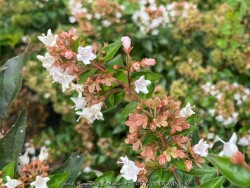

Raspberry Profusion Abelia (Abelia chinensis 'Raspberry Profusion') is a compact rounded, spreading, multi-stemmed shrub in the honeysuckle family. Typically grows on gracefully arching branches to 2-4' tall. 'Raspberry Profusion', a seedling selection of 'Edward Goucher' x chinensis, blooms heavily from May to September. The entire plant is covered with big clusters of strongly-scented, pink flowers with flamboyant raspberry sepals. The sepals remain after the flowers drop, extending the color until the end of autumn. New growth emerges glossy red and ages to a handsome dark green. The shrub is robust and compact, growing to 3-4' tall and wide. It is mostly deciduous in the winter. Semi-evergreen dark green leaves turn purplish-bronze in autumn persisting until 10 degrees F or so. Wood is hardy to 0 degrees F. In years where the stems die to the ground in winter but the plant survives, flowering will still occur on new growth. 'Raspberry Profusion' Abelia (Abelia chinensis 'Raspberry Profusion') is an unusually hardy abelia, thriving even in zone 5b. Abelia is also known for it's fragrant flowers that attract butterflies and hummingbirds, plus it's shade-tolerant and resistant to both deer and rabbits. Graceful, arching habit makes it a perfect choice for late season fragrance in your landscape.
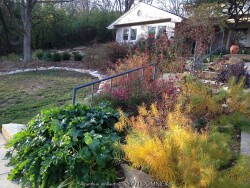

Bear's Breeches / Acanthus is a clump-forming perennial that is grown as much for its attractive dark green foliage as for its architecturally bold flower spikes. It is native to the Mediterranean region. Flowers are creamy white (sometimes pinkish) and snapdragon-like. Foliage is mostly evergreen in warm winter climates, but plants lose their leaves when winter temperatures dip below 20°F. Foliage is usually persisting until mid-early December in Kansas. If low temperatures hit -10 degrees F, it may kill an un-mulched plant; protect any zone 6 perennial with thick layer of mulch. Established plants survived -16 degrees F and a week of single digit highs in February, 2021. Acanthus may be grown a potted patio plant for full to part shade. Grown in a raised pot, they are hardy to about 15-20° so you may be able to miss the first few frosts when moving them in for the winter. Before extreme cold, overwinter in a dark garage or basement with monthly watering to encourage dormancy. Alternatively, it can maintain growing in a bright window as a houseplant. Either way, they will hold up very well in the winter and maintain their attractive foliage. In spring, just cut off dead foliage and place back out in April or May with a time-release fertilizer.
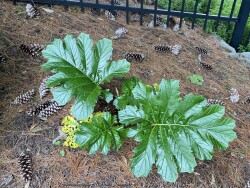

Bear's Breeches / Acanthus is a clump-forming perennial that is grown as much for its attractive dark green foliage as for its architecturally bold flower spikes. It is native to the Mediterranean region. Flowers are creamy white (sometimes pinkish) and snapdragon-like. Foliage is mostly evergreen in warm winter climates, but plants lose their leaves when winter temperatures dip below 20°F. Foliage is usually persisting until mid-early December in Kansas. If low temperatures hit -10 degrees F, it may kill an un-mulched plant; protect any zone 6 perennial with thick layer of mulch. Established plants survived -16 degrees F and a week of single digit highs in February, 2021. Acanthus may be grown a potted patio plant for full to part shade. Grown in a raised pot, they are hardy to about 15-20° so you may be able to miss the first few frosts when moving them in for the winter. Before extreme cold, overwinter in a dark garage or basement with monthly watering to encourage dormancy. Alternatively, it can maintain growing in a bright window as a houseplant. Either way, they will hold up very well in the winter and maintain their attractive foliage. In spring, just cut off dead foliage and place back out in April or May with a time-release fertilizer. Acanthus mollis 'Wofford Rhubarb' features beautiful red leaf stalks.
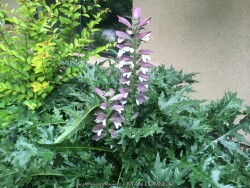

Spiny Bear's Breeches (Acanthus spinosus) is a clump-forming perennial that is grown as much for its attractive dark green foliage as for its architecturally bold flower spikes. The foliage of this species deeply cut and rather spiny looking dark-green leaves without actual spines. Flowers are creamy white (sometimes pinkish) and snapdragon-like and DO have sharp spines! It is the most thistly-looking of any of the various forms available. Foliage is mostly evergreen in warm winter climates, but plants lose their leaves when winter temperatures dip below 20°F. Foliage is usually persisting until mid-early December in Kansas. If low temperatures hit -10 degrees F, it may kill an un-mulched plant; protect any zone 6 perennial with thick layer of mulch. Established plants survived -16 degrees F and a week of single digit highs in February, 2021.
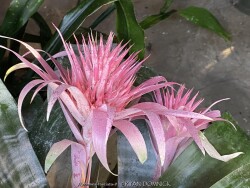

Silver Vase / Urn Plant (Aechmea fasciata) is an exotic-looking flowering plant from the bromeliad (Bromeliaceae) family. Despite its exotic appearance and tropical nature, this bromeliad adapts well to living as a potted house plant. In Kansas, use as a summer patio plant and protect from direct sunlight in mid summer and any temperatures below 50 degrees F in the spring or fall. As an epiphyte, much of its water needs are met by keeping the plants center "Urn" filled with water once per week or two. They have a shallow root systems and probably won't ever need repotted. When flowering, the flowers themselves are short-lived, but the pink and red bracts last for a few months.
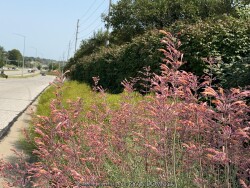

Sunset Agastache (Agastache rupestris) is a cold hardy, native hybrid perennial that blooms from mid to late summer and sporadically into the fall. This variety features a profusion of orange and pinkish flowers that attract hummingbirds and bumblebees. Both the flowers and foliage have a strong minty licorice scent when touched, and aromatic foliage helps to deter both deer and rabbits. Having desert heritage, it resents poor drainage and winter moisture. To counteract that in Kansas, plant in full sun on berm with poor sandy or rocky soil with no irrigation.


Five leaf Akebia (Akebia quinata) is a twining vine with green leaves arranged in a palmate shape. Maroon to purple flowers have the slight aroma of chocolate and bloom early in the spring. As with most vines, they are not low maintenance due to their nature and purpose in life. Vines by nature are kind of like freeloaders that want to use other things (and other plants) for free support. This does not directly parasitize the tree but can add a lot of weight (storm damage) and shade out it's foliage. It requires training to grow on some structures but will generally twine and try to grow to the highest point possible. When properly trained on a trellis or pergola, akebia can be amazing. It will grow in just about any soil and tolerate full shade to full sun. It may be used as a groundcover if nothing to climb on or an edible plant if you pollinate the flowers by hand. There are varieties available that when crossed, produce edible fruit. Akebia is invasive in some parts of the country but this is not the case in Kansas. Blooms occur in march or april very early when frosts are still occurring but with little damage to the plant. Foliage is persistent and semi evergreen until 10-15 degrees F.
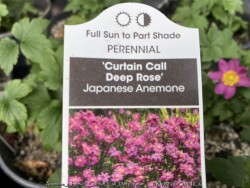

***Description for this perennial available with future update!***
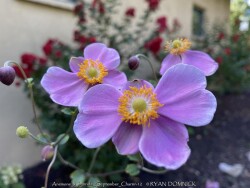

This group of herbaceous perennials are all the result of crossing two or three species, A. hupehensis, A. vitifolium, and A. tomentosa. Many cultivars now exist. Most of which flower white or pink in late summer and fall providing valuable color when many other plants have past their prime. Plants appreciate organically rich, humusy, evenly moist, well-drained soils in morning sun to part shade. Summer moisture leading upto flowering is important to avoid tattered, burnt foliage. Dark green basal growth foliage is semi-evergreen and clump-forming but plants will spread slowly. Anemone x hybrida 'September Charm' is a vigorous hybrid that typically grows to 3-4' tall and provides excellent late summer to early fall bloom from late August to October. Large silvery pink flowers with darker rose shadings and yellow center stamens appear on long, wiry-but-graceful, branching stems over an attractive foliage mound.
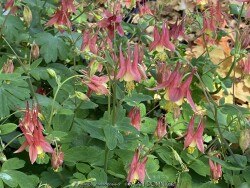

Aquilegia canadensis is a columbine native to Kansas with more tolerance for drought, heat and humidity. It still prefers cool nights preferring rich, moist soils with light to moderate shade. By keep soils uniformly moist after during and after bloom, the attractive foliage will last into June or July in Kansas. When foliage depreciates from drought or leaf miners, the plants may be cut to the ground with some regrowth and flowering possible in the fall. Flowers are reddish pink with yellow shades inside. Great for hummingbirds!
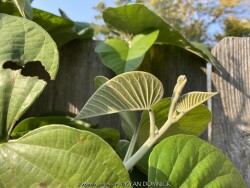

Wooly Morning Glory (Argyreia nervosa) is the most rapidly growing annual vine in out library capable of growing 15-30' in one summer! Native to tropical rainforests of India, it can fill a large trellis or arbor with bright green foliage with silver backs and stems after 1 month. It thrives when planted in May by taking advantage of early summer rains, heat and humidity. It needs typical garden soil and regular moisture. In Eastern Kansas, typically our 40 inches of rainfall is sufficient without extra water in good soils. The flowers are 2-3" across but are usually not present the first year and thus not significant as an annual. It is absolutely gorgeous and wild looking with its foliage alone. If growing as a potted plant and trying to overwinter, it is very difficult as these plants do not like low humidity or low light; best to replace each year.
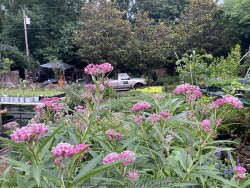

Pink Swamp Milkweed (Asclepias incarnata) is a herbaceous perennial plant species native to North America. The foliage is bright green and upright. The blooms occurring in early to mid-summer are pink to mauve (sometimes white). After blooming, green seed pods are attractive. They finally split open in late summer releasing silver fluffy floating seeds that are whisked away in the wind. This same natural mechanism for seed dispersal is similar to that used by most other milkweed (Asclepias) species. Fall color is an attractive yellow to gold with red highlights. It is frequently grown as a bog plant needing constantly moist soil rich in organic matter. As a rain garden plant, it will thrive is a depressed area in the landscape that collects rain water from a roof during spring and summer periods of rain but then go dormant if the water hole dries out completely. This species is not shade-tolerant and will get crowded out if the rain garden becomes too dense. Pink Swamp Milkweed may also be grown in average garden soils provided extra water is supplied during droughts. It is cultivated as a garden plant for butterflies and birds at all life stages: foliage for caterpillars, nectar for butterflies and other insects, and seeds for birds. It has a latex sap containing toxic chemicals that helps it repel other insects and other herbivorous animals. In the home landscape, this species does not spread like some other milkweeds. The plant is also timid about self-seeding because seeds have to germinate in mud and quickly die if it dries out. No worries about invasiveness with this one, just count on it being a beautiful tall perennial for many years in the garden! The species is not shade-tolerant and is not a good vegetative competitor.
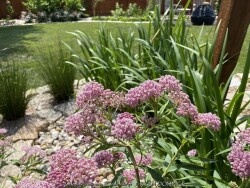

Pink Swamp Milkweed (Asclepias incarnata) is a herbaceous perennial plant species native to North America. The foliage is bright green and upright. The blooms occurring in early to mid-summer are pink to mauve (sometimes white). After blooming, green seed pods are attractive. They finally split open in late summer releasing silver fluffy floating seeds that are whisked away in the wind. This same natural mechanism for seed dispersal is similar to that used by most other milkweed (Asclepias) species. Fall color is an attractive yellow to gold with red highlights. It is frequently grown as a bog plant needing constantly moist soil rich in organic matter. As a rain garden plant, it will thrive is a depressed area in the landscape that collects rain water from a roof during spring and summer periods of rain but then go dormant if the water hole dries out completely. This species is not shade-tolerant and will get crowded out if the rain garden becomes too dense. Pink Swamp Milkweed may also be grown in average garden soils provided extra water is supplied during droughts. It is cultivated as a garden plant for butterflies and birds at all life stages: foliage for caterpillars, nectar for butterflies and other insects, and seeds for birds. It has a latex sap containing toxic chemicals that helps it repel other insects and other herbivorous animals. In the home landscape, this species does not spread like some other milkweeds. The plant is also timid about self-seeding because seeds have to germinate in mud and quickly die if it dries out. No worries about invasiveness with this one, just count on it being a beautiful tall perennial for many years in the garden! The species is not shade-tolerant and is not a good vegetative competitor.
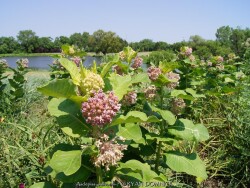

***Description for this perennial available with future update!***


***Description for this perennial available with future update!***
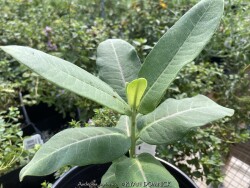

***Description for this perennial available with future update!***
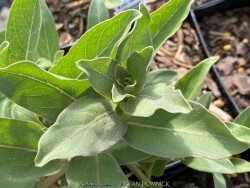

***Description for this perennial available with future update!***
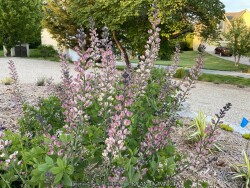

The False Indigo species (Baptisia) features beautiful compact bluish green leaves arranged in groups of three. Like many members in the legume family, they are nitrogen fixing plants which means they produce their own nitrogen in the soil through a symbiotic relationship with bacteria. The flowers bloom above the foliage normally in April and May. Common baptisia flower colors include white, purple, lavender, yellow, and pink as well as uncommon colors ranging from deep purple to maroon and even coppery orange. Considered a great North American native three season plant, the foliage always emerges very attractive followed by flowers that do not need deadheading. Foliage generally lasts pretty nice through hot summers and into fall turning black with first freeze. Seed pods also turn charcoal black when ripe and have considerable ornamental interest and useful in dried flower arrangements. At some point in the fall, it can be cut down early for a clean look or left for winter interest. Baptisia generally do well in droughty clay soils in full to part sun. There is only one pest that may create problems called the Genista Broom Moth. It may occur in Kansas when weather conditions are consistently dry and over 95 degrees F. It is treatable if you act fast but if not, it only destroys the foliage late in the season and does not kill the plant. Baptisia has several enormous spreading taproots which store water and energy and can make transplanting difficult. Plantings look good as specimen or in small groups; and it's ok even preferable if they grow together and touch other plants. That helps eliminate available sunlight and discourages weeds. It is hard to picture a native plant garden or any perennial garden without Baptisia. Considered a once "it's there, it's always there" long lived plant. Baptisia 'Pink Truffles' is an excellent vigorous pink flowered selection; quite a color break-thru for Baptisia! Clear soft pink blossoms with a pale yellow keel are produced in late spring on bright green foliage. Its compact, shorter habit makes it easy to fit into any garden. This extremely long-lived perennial could be used instead of a shrub in landscape settings, with minimal care required to thrive year after year. This plant is a member of the DECADENCE® series from Walters Gardens, Inc.
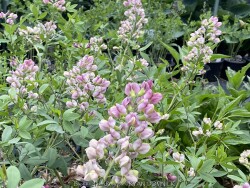

The False Indigo species (Baptisia) features beautiful compact bluish green leaves arranged in groups of three. Like many members in the legume family, they are nitrogen fixing plants which means they produce their own nitrogen in the soil through a symbiotic relationship with bacteria. The flowers bloom above the foliage normally in April and May. Common baptisia flower colors include white, purple, lavender, yellow, and pink as well as uncommon colors ranging from deep purple to maroon and even coppery orange. Considered a great North American native three season plant, the foliage always emerges very attractive followed by flowers that do not need deadheading. Foliage generally lasts pretty nice through hot summers and into fall turning black with first freeze. Seed pods also turn charcoal black when ripe and have considerable ornamental interest and useful in dried flower arrangements. At some point in the fall, it can be cut down early for a clean look or left for winter interest. Baptisia generally do well in droughty clay soils in full to part sun. There is only one pest that may create problems called the Genista Broom Moth. It may occur in Kansas when weather conditions are consistently dry and over 95 degrees F. It is treatable if you act fast but if not, it only destroys the foliage late in the season and does not kill the plant. Baptisia has several enormous spreading taproots which store water and energy and can make transplanting difficult. Plantings look good as specimen or in small groups; and it's ok even preferable if they grow together and touch other plants. That helps eliminate available sunlight and discourages weeds. It is hard to picture a native plant garden or any perennial garden without Baptisia. Considered a once "it's there, it's always there" long lived plant. Baptisia 'Plum Rosy' is an excellent vigorous pink and white flowered selection; quite a color break-thru for Baptisia! Pink blossoms age to white creating a bi-colored effect in late spring on bright green foliage. This full-size but dense habit can work like a shrub in any garden. This extremely long-lived perennial could be used instead of a shrub in landscape settings, with minimal care required to thrive year after year. This plant was introduced from Walters Gardens, Inc.
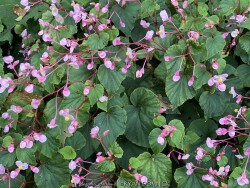

Hardy Begonia (Begonia grandis) is planted for its attractive green foliage with reddish stems along with its breathtaking summer/fall pink flower display. It is a tuberous-rooted, clump-forming perennial that typically forms a bushy mound of foliage to 2' tall on branching stems. Foliage maintains well all season provided that certain cultural conditions are met. Native to forests with humusy, medium to wet, well-drained soil in part shade to full shade, it needs constantly moist soil rich in organic matter but avoid clay. Good late summer flowering shade plant which mixes well with hostas and ferns in the shade garden. Tolerates heavy shade and black walnut trees. Generally this plant declines after a few years of Kansas climate if dealing with summer droughts but worth a try in rich organic soils in well-tended shade gardens. Where happy, plants can multiply quickly and flower continuously in summer. If low temperatures hit -10 degrees F, it may kill an un-mulched plant; protect any zone 6 perennial with thick layer of mulch. An large established grouping exists at OSU Botanical Gardens in Stillwater, OK. This grouping has proven hardy with 2-3" of mulch and lows down to -14 degrees F on Feb 16th, 2021. The longevity of this cold blast was also impressive: 12 days on a row with highs below 32 degrees F, 7 nights of lows in the single digits and negatives and 48-60 hours of 5 degrees F and mostly lower. A hard ground freeze was inevitable with no damage to tubers.


Crossvine (Bignonia capreolata) is a highly ornamented evergreen vine native to the southeast west to Oklahoma and Texas. Fantastic blooms completely cover the plant and occur on old wood in the late spring for about 3-5 weeks then sporadically during the summer. Flowers are trumpet-shaped, orange and red with yellow throats. Although in the same family as trumpet vine (campus radicans), crossvine is not invasive. Plant crossvine on fences or pergolas where you want good coverage but not anything sprawling too far away from the structure needing pruning. Considered to be one of the lowest maintenance of all vines. Crossvine prefer for part to full sun on in medium to rich soils and are able to tolerate drought and brief flooding once established. There are no serious pests or diseases to worry about. Crossvine has thrived in our Lawrence Kansas zone 6a display garden for over 15 years enduring a few occasions of -10° or colder winters. Winter foliage turns purple and remains evergreen till about -10. We have seen -18° without any dieback on the vine other than the loss of foliage that year. This great vine has it all, beautiful flowers, evergreen foliage, and constrained growth habit! Dressed To Thrill Crossvine (Bignonia capreolata 'Dressed To Thrill') is colorful, extremely floriferous, and amazingly adaptable! his selection of our North American native crossvine transforms fences, walls, and trellises into a wall of flowers, climbing structures by tendrils. Orange-red trumpet-shaped flowers with bright yellow eyes enliven landscapes from spring through summer and provide a welcome food source for hummingbirds. Native from Ohio down to Texas, this semi-evergreen vine is adaptable to most any soil and exhibits excellent heat and drought tolerance.
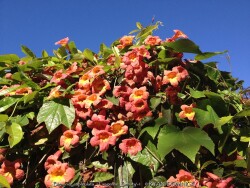

Crossvine (Bignonia capreolata) is a highly ornamented evergreen vine native to the southeast west to Oklahoma and Texas. Fantastic blooms completely cover the plant and occur on old wood in the late spring for about 3-5 weeks then sporadically during the summer. Flowers are trumpet-shaped, orange and red with yellow throats. Although in the same family as trumpet vine (campus radicans), crossvine is not invasive. Plant crossvine on fences or pergolas where you want good coverage but not anything sprawling too far away from the structure needing pruning. Considered to be one of the lowest maintenance of all vines. Crossvine prefer for part to full sun on in medium to rich soils and are able to tolerate drought and brief flooding once established. There are no serious pests or diseases to worry about. Crossvine has thrived in our Lawrence Kansas zone 6a display garden for over 15 years enduring a few occasions of -10° or colder winters. Winter foliage turns purple and remains evergreen till about -10. We have seen -18° without any dieback on the vine other than the loss of foliage that year. This great vine has it all, beautiful flowers, evergreen foliage, and constrained growth habit! Bignonia capreolata 'Tangerine Beauty' is noted for its tangerine flowers and slightly improved cold hardiness.
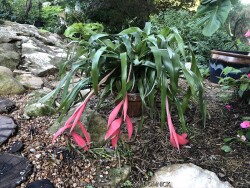

***Description for this plant available with future update!***Billbergia Bromeliad / Friendship Plant (Tropical), is also known as Billbergia nutans
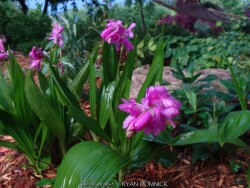

Hardy Ground Orchid (Bletilla striata) is planted for its attractive green foliage with and amazing spring flower display of pink and magenta "orchid-like" flowers. Foliage maintains well all season provided that certain cultural conditions are met. Native to Chinese forests with humusy, well-drained soil in part shade to full shade, it needs constantly moist to average soil rich in organic matter but avoid clay. If low temperatures hit -10 degrees F, it may kill an un-mulched plant; protect any zone 6 perennial with thick layer of mulch. I have occasionally seen entire plantings wiped out at -10 to15 degrees F with no mulch or snow cover. Good late summer flowering shade plant which mixes well with hostas and ferns in the shade garden. Generally this plant has declined after a few years in our Kansas display garden but worth a try in perfect soils in well-tended shade gardens.
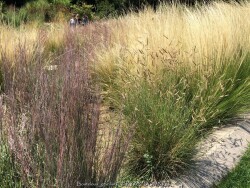

Blue Grama Grass (Bouteloua gracilis) is a long-lived, clump-forming, warm-season, perennial grass native to North America. It is one of the dominant grasses of the dry shortgrass prairies. Blue grama has very thin green to greyish leaves that turn golden brown in autumn, sometimes also developing interesting shades of orange. Purplish-tinged eyebrow-shaped flowers appear on arching stems above the foliage in early to mid-summer. Height before flowering is 12-15" increasing to 24" after flowering. As a native to the Great Plains, blue grama displays excellent drought tolerance but tolerates a wide range of soils. Avoid poorly-drained soils. In Eastern Kansas, typically our 40 inches of rainfall is sufficient without extra water. Occasionally suffering from excessive rainy spells and high humidity, foliage rust diseases can be a problem in shade or poor air circulation areas. To counteract that in Kansas, plant in full sun on berm with poor sandy, rocky, or clay soil with no irrigation. Blue grama grass works very well in an ornamental grass garden adding contrast, texture, and short stature. Use as mass plantings to create a drift that can be enjoyed from far away. For mass plantings, plant individual plants close together as they don't spread much. Dried foliage holds up very well in the winter offering a one-of-a-kind look. The only maintenance is to cut down or burn before new growth emerges. Combine with other flowering prairie native perennials for a long season of interest. Also useful as a full-sun turf grass for extremely dry or sandy soils or where buffalo grass doesn't work. It can be regularly mowed to 3-4" high.


Brugmansia is a genus of seven species of flowering plants in the nightshade family Solanaceae from South America. It is typically grown in warmer zones as a shrub or tree but is extinct from the wild (only known in cultivation). Along with other tropicals and succulents in Kansas, Angel Trumpet Flower is usually grown as summer patio plant with amazing foot-long hanging flowers and sweet aroma. Water regularly and place in full sun or part shade. Protect from temperatures below 32 degrees F and move into a cold garage or basement over the winter with minimal watering. Do not allow the pot with rootball to freeze solid or go below 28 degrees for more than a few hours. Allow to go dormant as needed with little care, just cut off dead foliage/twigs and place back out in April or May with a time-release fertilizer. You may also propagate this plant easily by cutting off dormant twigs/branches and stuffing them into the ground. Notice that I didn't say rooting hormone or even being careful was necessary! Landscapers also plant these as an annual in the ground for an enormous tropical effect with fragrant flowers and growth reaching 5-8' in one season from a 1gal container! It is possible to overwinter Brugmansia in the ground in Kansas as a woody perennial. In our trial gardens in Lawrence, KS (zone 6a), a one year established specimen planted in our annual bed was mulched 12-18" thick with leaf mulch survived -10 degrees F. The dieback was deep into the ground but somehow came back from a piece of deep root. The leaf mulch was also well rotted and formed somewhat of an ice barrier insulating effect. Brugmansia species are amongst the most toxic of ornamental plants so do not eat and part of this plant! Brugmansia 'Charles Grimaldi' features orange flowers.
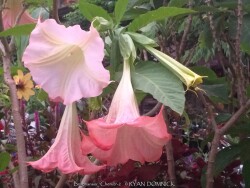

Brugmansia is a genus of seven species of flowering plants in the nightshade family Solanaceae from South America. It is typically grown in warmer zones as a shrub or tree but is extinct from the wild (only known in cultivation). Along with other tropicals and succulents in Kansas, Angel Trumpet Flower is usually grown as summer patio plant with amazing foot-long hanging flowers and sweet aroma. Water regularly and place in full sun or part shade. Protect from temperatures below 32 degrees F and move into a cold garage or basement over the winter with minimal watering. Do not allow the pot with rootball to freeze solid or go below 28 degrees for more than a few hours. Allow to go dormant as needed with little care, just cut off dead foliage/twigs and place back out in April or May with a time-release fertilizer. You may also propagate this plant easily by cutting off dormant twigs/branches and stuffing them into the ground. Notice that I didn't say rooting hormone or even being careful was necessary! Landscapers also plant these as an annual in the ground for an enormous tropical effect with fragrant flowers and growth reaching 5-8' in one season from a 1gal container! It is possible to overwinter Brugmansia in the ground in Kansas as a woody perennial. In our trial gardens in Lawrence, KS (zone 6a), a one year established specimen planted in our annual bed was mulched 12-18" thick with leaf mulch survived -10 degrees F. The dieback was deep into the ground but somehow came back from a piece of deep root. The leaf mulch was also well rotted and formed somewhat of an ice barrier insulating effect. Brugmansia species are amongst the most toxic of ornamental plants so do not eat and part of this plant! Brugmansia 'Cherub' features bright pink flowers.
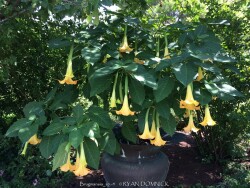

Brugmansia is a genus of seven species of flowering plants in the nightshade family Solanaceae from South America. It is typically grown in warmer zones as a shrub or tree but is extinct from the wild (only known in cultivation). Along with other tropicals and succulents in Kansas, Angel Trumpet Flower is usually grown as summer patio plant with amazing foot-long hanging flowers and sweet aroma. Water regularly and place in full sun or part shade. Protect from temperatures below 32 degrees F and move into a cold garage or basement over the winter with minimal watering. Do not allow the pot with rootball to freeze solid or go below 28 degrees for more than a few hours. Allow to go dormant as needed with little care, just cut off dead foliage/twigs and place back out in April or May with a time-release fertilizer. You may also propagate this plant easily by cutting off dormant twigs/branches and stuffing them into the ground. Notice that I didn't say rooting hormone or even being careful was necessary! Landscapers also plant these as an annual in the ground for an enormous tropical effect with fragrant flowers and growth reaching 5-8' in one season from a 1gal container! It is possible to overwinter Brugmansia in the ground in Kansas as a woody perennial. In our trial gardens in Lawrence, KS (zone 6a), a one year established specimen planted in our annual bed was mulched 12-18" thick with leaf mulch survived -10 degrees F. The dieback was deep into the ground but somehow came back from a piece of deep root. The leaf mulch was also well rotted and formed somewhat of an ice barrier insulating effect. Brugmansia species are amongst the most toxic of ornamental plants so do not eat and part of this plant! Flowers come in Orange, Red, Pink, and White.


Brugmansia is a genus of seven species of flowering plants in the nightshade family Solanaceae from South America. It is typically grown in warmer zones as a shrub or tree but is extinct from the wild (only known in cultivation). Along with other tropicals and succulents in Kansas, Angel Trumpet Flower is usually grown as summer patio plant with amazing foot-long hanging flowers and sweet aroma. Water regularly and place in full sun or part shade. Protect from temperatures below 32 degrees F and move into a cold garage or basement over the winter with minimal watering. Do not allow the pot with rootball to freeze solid or go below 28 degrees for more than a few hours. Allow to go dormant as needed with little care, just cut off dead foliage/twigs and place back out in April or May with a time-release fertilizer. You may also propagate this plant easily by cutting off dormant twigs/branches and stuffing them into the ground. Notice that I didn't say rooting hormone or even being careful was necessary! Landscapers also plant these as an annual in the ground for an enormous tropical effect with fragrant flowers and growth reaching 5-8' in one season from a 1gal container! It is possible to overwinter Brugmansia in the ground in Kansas as a woody perennial. In our trial gardens in Lawrence, KS (zone 6a), a one year established specimen planted in our annual bed was mulched 12-18" thick with leaf mulch survived -10 degrees F. The dieback was deep into the ground but somehow came back from a piece of deep root. The leaf mulch was also well rotted and formed somewhat of an ice barrier insulating effect. Brugmansia species are amongst the most toxic of ornamental plants so do not eat and part of this plant! Flowers come in Orange, Red, Pink, and White.
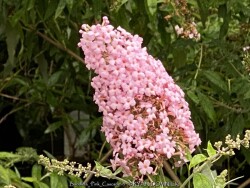

Butterfly Bush (Buddleia) are workhorses in the pollinator garden. Flower panicles come in a variety of colors mostly including shades of lavender, magenta, violet, pink, and white. Most Butterfly Bushes bloom on new wood so trimming off winter kill or complete rejuvenation will not affect flowering. In fact, flowering is often bigger and bolder from new water sprout growth when trimmed to the ground each year. Most Butterfly Bushes in zone 6 are maintained this way. Foliage is typically an attractive greenish-gray to mint green and persists into the fall until hard freezes occur. Use in the landscape in small or large groupings for its amazing flower power! Plants grow best in full sun with medium to dry soils. Drought tolerance is high with established plants so extra watering is rarely needed in our East Kansas climate with 40 inches of rain per year. Obviously, Butterfly Bush attracts lots of butterflies. There has been some debate in recent years on whether to plant Butterfly Bush because it's a non-native plant. Being a native of China, it has no pest or disease problems here. It is invasive in some parts of the country but cold Kansas winters keep it and check and without any self-seeding problems here. If you are still worried about it, there are several sterile varieties to choose from. There have been many drastically improved cultivars in the last 10 years aiming to improve cold hardiness, bloom size, eliminate seeding, and improve growth habits. Buddleia 'Pink Cascade' is an introduction by Walters Gardens, Inc. Unlike the typical Butterfly Bush, the panicles on this flowering shrub cascade downward, similar to the look of weeping willow or a bridalwreath spirea. Light apple blossom pink flower panicles are 8-10" long. Minty green leaves, in combination with the flowers, give it overall cool tones. Use as a focal piece in your garden or in the landscape. In Eastern Kansas, 'Pink Cascade' has performs WELL for over 3 years with just about everything nature has to challenge it! This is a larger Butterfly Bush growing to 5-6' but still dense and compact in appearance. Combine with caryopteris and crapemyrtle to create a late season "all you can eat" buffet for pollinators!


Butterfly Bush (Buddleia) are workhorses in the pollinator garden. Flower panicles come in a variety of colors mostly including shades of lavender, magenta, violet, pink, and white. Most Butterfly Bushes bloom on new wood so trimming off winter kill or complete rejuvenation will not affect flowering. In fact, flowering is often bigger and bolder from new water sprout growth when trimmed to the ground each year. Most Butterfly Bushes in zone 6 are maintained this way. Foliage is typically an attractive greenish-gray to mint green and persists into the fall until hard freezes occur. Use in the landscape in small or large groupings for its amazing flower power! Plants grow best in full sun with medium to dry soils. Drought tolerance is high with established plants so extra watering is rarely needed in our East Kansas climate with 40 inches of rain per year. Obviously, Butterfly Bush attracts lots of butterflies. There has been some debate in recent years on whether to plant Butterfly Bush because it's a non-native plant. Being a native of China, it has no pest or disease problems here. It is invasive in some parts of the country but cold Kansas winters keep it and check and without any self-seeding problems here. If you are still worried about it, there are several sterile varieties to choose from. There have been many drastically improved cultivars in the last 10 years aiming to improve cold hardiness, bloom size, eliminate seeding, and improve growth habits. Buddleia x 'Pugster Pinker' is the newest member of a unique series that offers full-sized flowers on dwarf plants. This compact Butterfly Bush reaches just 2-3' tall and wide but has the large, full flowers normally seen on a much larger plant. It blooms non-stop from early summer through frost with very rich pink flowers, each with a tiny bright orange eye in the center. Thanks to thick, sturdy stems, the Pugster® series offers vastly improved hardiness and winter survival over other types of dwarf Butterfly Bush. Thanks to its long-blooming habit, Pugster Butterfly Bushes add low-maintenance color to any sunny spot in your yard. The name "Pugster" comes from these plants' resemblance to a pug - short, stocky, and cute! In Eastern Kansas, this cultivar performs WELL with just about everything nature has to challenge it! Heat and drought are tolerated. Cold tolerance is no problem in our zone 6. If winter die-back occurs, cut back in March/April and flowers will occur on new growth this year. No disease or pest problems. Combine with caryopteris and crapemyrtle to create a late season "all you can eat" buffet for pollinators! All Proven Winners® plants are legally propagated, healthy and vigorous, true to name, and tagged with color pictures and growing information.
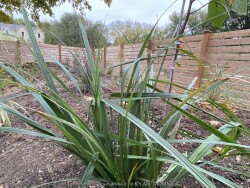

***Description for this grass available with future update!***Korean Feather Reed Grass, is also known as Calamagrostis brachytricha
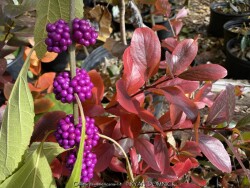

American Beautyberry (Callicarpa americana), native to Southeast US including Oklahoma and Missouri, is one of the most unique and attractive shrubs for berry production. Considered a three-season shrub, green foliage emerges in spring with attractive clusters of tiny pink flowers in summer. Big conglomerates of fruit clusters occur along the stem at evenly spaced intervals. Bright purple in color, the fruit is very effective through the month of October and November in our Zone 6a Kansas climate. Fall foliage is bright yellow often contrasting with the purple berries in November. By the following spring, winter kill to the ground will almost always occur as temperatures regularly drop to 0 degrees F or below. Cut to a few inches off the ground as you would with a perennial. You may choose to do this rejuvenation anyways in Southern areas if it has not been done in a few years to increase fruit production on vigorous new growth. New shoots create fountain-shaped shrub 3-4' after rejuvenation. Flowering occurs on new wood so you will always have berries when using this method. Purple berry clusters are highly ornamental and eaten only very slowly (never stripped clean) by birds. In southern parts of its range, full to part shade is best. However, full to part sun is recommended in zone 6 to maximize energy production needed from the sun in a shorter growing season. Mild drought is tolerated at the expense of dropping fruits if it gets too dry. Our plants in the display garden survived the winter of 2021 with temperatures reaching -16 degrees F coming up reliably from the ground each year. Overall, this is a great "woody perennial" for the Kansas landscape that is unfortunately often underused.
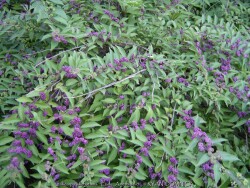

Purple beautyberry (Callicarpa dichotoma 'Early Amethyst'), native to Asia, is one of the most unique and attractive shrubs for berry production. Considered a three-season shrub, green foliage emerges in spring with attractive clusters of tiny pink flowers in summer. Big conglomerates of fruit clusters occur along the stem at evenly spaced intervals. Bright purple in color, the fruit is very effective through the month of October and November in our Zone 6a Kansas climate. Fall foliage is bright yellow often contrasting with the purple berries in November. The following spring, watch for winter kill if temperatures drop below -5 to -10 degrees F and be prepared to cut to a few inches off the ground. You may choose to do this rejuvenation anyways if it has not been done in a few years to increase fruit production on vigorous new growth. New shoots create fountain-shaped shrub 3-4' after rejuvenation. Flowering occurs on new wood so you will always have berries when using this method. Purple berry clusters are highly ornamental but rarely eaten (or stripped clean) by birds. Beautyberry grow best in part to full sun but can also tolerate almost full shade and still produce fruit. This makes them valuable for a north side of the house planting that only gets a couple of months of sun during the high sun angle peak of summer. Mild drought is tolerated at the expense of dropping fruits if it gets too dry. Our plants in the display garden survived without irrigation but did not fruit during the extreme drought of 2011. Overall this is a great plant for the landscape that is unfortunately often underused.


With its glossy burgundy-red foliage, Red Zeppelin sweetshrub (Calycanthus floridus var. purpureus) will rock your world! The color of the foliage lasts all season and is accompanied by lightly fragrant orange-red flowers in late spring and early summer. Not only is it adaptable and easy to grow in the landscape, but our many years of trialing indicate it’s easy to grow in production, too. This selection of our North American native species was developed by the folks at Pleasant Run Nursery. Prune after flowering to maintain shape. Calycanthus perform amazingly well in eastern Kansas landscapes. It is great along a woodland edge or in morning sun, or in full sun for best foliage color show. It tolerates a wide variety of soil types including clay but needs prefers well-drained soil high in organic matter. Adaptable to mild drought and heat but greatly improved with rich, moisture-retentive soils. Typically, our 40 inches of rainfall per year in Eastern Kansas is sufficient. Summer foliage is virtually pest-free. All Proven Winners® plants are legally propagated, healthy and vigorous, true to name, and tagged with color pictures and growing information.
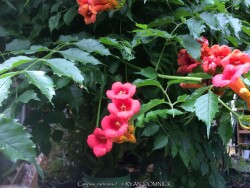

Trumpet vine (Campsis radicans) features shiny dark green foliage, orange-red trumpet-shaped summer flowers, green bean-like seed pods, and gold fall color. Flowers are very attractive to hummingbirds. Trumpet vine is native to the eastern United States including Kansas. Easily grown in a wide variety of soils including heady clay. It is usually grown on pergolas, trellises, and chain-link fences. Beware that this is an extremely vigorous plant that crowds out most weeds and is itself weed-like, with a very spreading growth habit. Best planted and allowed to grow in isolated areas or in horrible soils where no other plant will grow; mowing around it generally stops the yearly spread. Three beautifum mature plants in our display garden grow up posts on the North side of our covered awning behind our shop. They have been thriving for 15 plus years, growing in extremely compacted ab-3 gravel smashed into clay "soil" that is driven on by trucks and constantly walked on. A pick-axe will bounce off with each powerful swing! Now that is a tough "Once it's there, it's there forever" plant!
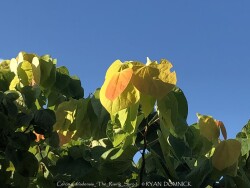

***Tree descriptions available with future update!***


***Description for this hardy tropical available with future update!***>>>>>Desert Willow is a small open irregularly branched tree or large shrub with bright green narrow leaves (but not related to true willows) It features gorgeous pink, white and magenta snapdragon-like flowers with yellow throats. Blooming season is immensely long beginning in June continuing all summer until frost. Desert Willow grows in all soil types here in Kansas but prefers rich silty loam. It will not grow in excessively wet anaerobic soils though. Absolute full sun is needed for best growth to produce flowers and avoid spindlyness. In the landscape, Desert Willow can be used as a specimen shrub or small tree. It handles hot west for south locations very well. It's native range covers most of the Southwest and western Texas along streams and riparian areas. Being surprisingly cold hardy here, Several Desert Willow cultivars can be found at the Denver Botanic Gardens in Denver CO (zone 5b) and at the Dyck Arboretum in Hesston, Kansas (zone 6b). Bubba Desert Willow (Chilopsis linearis 'Bubba') has been thriving in our display garden and other Lawrence, KS locations for over 15 years and has endured temperatures as low as a -18. During the most severe winters, winter kills it down to the ground. However, just like Crapemyrtle or Butterfly Bush, Desert Willow blooms on new wood and at a young age with blooms even occurring on 3 foot tall nursery plants. Water sprout regrowth from established landscape plants is rapid with heights reaching 5-6'. These blooms are more numerous and larger than normal, especially with a handful of time-release fertilized applied in the early spring.


***Description for this plant available with future update!***
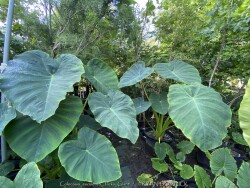

***Description for this plant available with future update!***>>>>> Plant Delights Nursery says "Colocasia esculenta 'Jack's Giant' is a plant that we received from Jack de Vroomen of Marlboro Bulb Company, who brought this to us from Costa Rica. The tuber was much larger and shaped differently from other Colocasia esculenta forms we had grown. In our garden, the plants easily reached 7' tall, even in a very dry section, with medium green leaves similar to typical Colocasia esculenta. We are pretty sure it is a triploid form, which should increase winter hardiness. (Hardiness Zone 7b-10)"
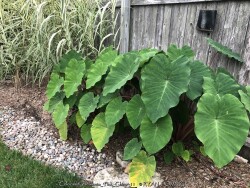

Pink China Hardy Elephant Ear (Colocasia 'Pink China') are typically grown for their large tropical foliage and pink stems. The plants are temperate and subtropical herbaceous perennial bulbs native to areas with a summer monsoon season and dry winter. Pink China Hardy Elephant Ear is hardy outside as a perennial when established and with minimal effort at least up to zone 6a. During the growing season, fertilize, water regularly, and plant in full sun. Plant these bulbs in the ground at least 3-6" deep with 3-4" of mulch. Foliage may look bedwraggled by fall if drought stressed so it is ok to cut back foliage at that time. Plants spread by running ryizomes but are easy to pull up if undesired. They can also be grown as a flowering summer patio plant. If growing as a potted plant and trying to overwinter, allowing the foliage to frost is ok, it will not kill the root system. However, do not allow the pot with rootball to freeze solid or go below 20 degrees for more than a few hours; move into a cold garage or basement over the winter with no watering. Cut back and allow to go dormant and place entire pot back out in April or May with a time-release fertilizer. If digging from the ground in colder zones, just save a big chunk with the dirt intact and place into a large pot in the garage. In our display garden in Lawrence, KS (zone 6a), several established specimens planted over 4-6" deep and mulched 2-3" with wood mulch survived -17 degrees F. During the arctic blast of February, 2021, lows down to -17 degrees F on Feb 16th, 2021 were recorded. The longevity of this cold blast was also impressive: 10 days on a row with highs of 10-15 degrees F or lower, 8 nights of lows in the single digits and negatives, and 36 straight hours of 0 degrees F and mostly lower. This plant can also be used as a marginal aquatic plant growing in shallow water. It can also grow as a bog plant needing constantly moist soil rich in organic matter. As a rain garden plant, it will thrive is a depressed area in the landscape that collects rain water from a roof during spring and summer periods of rain but then go dormant if the water hole dries out completely.


Pink China Hardy Elephant Ear (Colocasia 'Pink China') are typically grown for their large tropical foliage and pink stems. The plants are temperate and subtropical herbaceous perennial bulbs native to areas with a summer monsoon season and dry winter. Pink China Hardy Elephant Ear is hardy outside as a perennial when established and with minimal effort at least up to zone 6a. During the growing season, fertilize, water regularly, and plant in full sun. Plant these bulbs in the ground at least 3-6" deep with 3-4" of mulch. Foliage may look bedwraggled by fall if drought stressed so it is ok to cut back foliage at that time. Plants spread by running ryizomes but are easy to pull up if undesired. They can also be grown as a flowering summer patio plant. If growing as a potted plant and trying to overwinter, allowing the foliage to frost is ok, it will not kill the root system. However, do not allow the pot with rootball to freeze solid or go below 20 degrees for more than a few hours; move into a cold garage or basement over the winter with no watering. Cut back and allow to go dormant and place entire pot back out in April or May with a time-release fertilizer. If digging from the ground in colder zones, just save a big chunk with the dirt intact and place into a large pot in the garage. In our display garden in Lawrence, KS (zone 6a), several established specimens planted over 4-6" deep and mulched 2-3" with wood mulch survived -17 degrees F. During the arctic blast of February, 2021, lows down to -17 degrees F on Feb 16th, 2021 were recorded. The longevity of this cold blast was also impressive: 10 days on a row with highs of 10-15 degrees F or lower, 8 nights of lows in the single digits and negatives, and 36 straight hours of 0 degrees F and mostly lower. This plant can also be used as a marginal aquatic plant growing in shallow water. It can also grow as a bog plant needing constantly moist soil rich in organic matter. As a rain garden plant, it will thrive is a depressed area in the landscape that collects rain water from a roof during spring and summer periods of rain but then go dormant if the water hole dries out completely.


Big Dipper Hardy Elephant Ear (Colocasia gaoligongensis 'Big Dipper') are typically grown for their large tropical foliage and black stems. The plants are temperate and subtropical herbaceous perennial bulbs native to areas with a summer monsoon season and dry winter. Big Dipper Hardy Elephant Ear is hardy outside as a perennial when established and with minimal effort at least up to zone 6a. During the growing season, fertilize, water regularly, and plant in full sun. Plant these bulbs in the ground at least 3-6" deep with 3-4" of mulch. Foliage may look bedwraggled by fall if drought stressed so it is ok to cut back foliage at that time. Plants spread by running ryizomes but are easy to pull up if undesired. They can also be grown as a flowering summer patio plant. If growing as a potted plant and trying to overwinter, allowing the foliage to frost is ok, it will not kill the root system. However, do not allow the pot with rootball to freeze solid or go below 20 degrees for more than a few hours; move into a cold garage or basement over the winter with no watering. Cut back and allow to go dormant and place entire pot back out in April or May with a time-release fertilizer. If digging from the ground in colder zones, just save a big chunk with the dirt intact and place into a large pot in the garage. In our display garden in Lawrence, KS (zone 6a), several established specimens planted over 4-6" deep and mulched 2-3" with wood mulch survived -17 degrees F. During the arctic blast of February, 2021, lows down to -17 degrees F on Feb 16th, 2021 were recorded. The longevity of this cold blast was also impressive: 10 days on a row with highs of 10-15 degrees F or lower, 8 nights of lows in the single digits and negatives, and 36 straight hours of 0 degrees F and mostly lower. This plant can also be used as a marginal aquatic plant growing in shallow water. It can also grow as a bog plant needing constantly moist soil rich in organic matter. As a rain garden plant, it will thrive is a depressed area in the landscape that collects rain water from a roof during spring and summer periods of rain but then go dormant if the water hole dries out completely
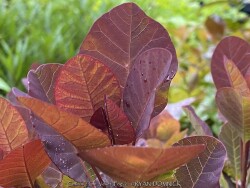

***Shrub descriptions available with future update!***>>>>>In the words of breeder Tim Wood - "It's got more smoke than a KISS concert!" (Cotinus 'The Velvet Fog') Very large pink plumes develop in mid-summer, covering the waxy blue-green foliage. It's a stunning color combination. The Velvet Fog smokebush (Cotinus 'The Velvet Fog') was selected for its outstanding flower production as well as its dense growth, providing a lusher look than conventional cotinus. Pruning will rarely be required but may be done in spring. It isn't technically the flowers that create the hazy, smoke-like effect this plant is so loved for - it's the seed pods that form after the flowers have faded. In Eastern Kansas, this cultivar performs WELL with just about everything nature has to challenge it! Heat and drought are preferred and need hot microclimate. Cold tolerance is no problem. Some leaf disease appears by late season from excessive rains and high humidity sometimes causing early defoliation. An important note about pruning: Do not attempt to rejuvinate an older tree/shrub in early fall. This will trick it into growing back rapidly to recover and them WHAM!.Arctic cold blast arrives killing any new growth not hardened off. This double sapps the tree for nutrients usually resulting in death by spring. All Proven Winners® plants are legally propagated, healthy and vigorous, true to name, and tagged with color pictures and growing information.
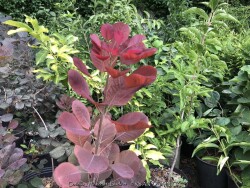

***Shrub descriptions available with future update!***>>>>>A feast for the eyes from spring through autumn! Winecraft Black® Smoketrtee (Cotinus 'Winecraft Black') is the first Proven Winners smokebush, so you know it must be special. In spring, round leaves emerge rich purple but as summer's heat comes on, they turn a deep near-black tone and finally light up in an array of reds and oranges in fall. In early summer, large, soft panicles of bloom appear that become the misty "smoke" that makes this such a popular landscape plant. Unlike other smokebush, it naturally has a rounded, dwarf habit which means that finally, every landscape has room for this unique plant. Top three reasons to grow Winecraft Black smokebush: 1.Color and interest from spring through frost. 2.No pruning or special maintenance required. 3.Dwarf habit makes it easy to use with any sized home or yard. Uses Notes: Smokebush makes a striking specimen, but is also effective as a low hedge or mass planting. Maintenance Notes: Winecraft Black smokebush is very easy to care for and requires little to nothing in the way of regular maintenance. Plant in full sun for best color and flowering. Pruning will rarely be required but may be done in spring. It isn't technically the flowers that create the hazy, smoke-like effect this plant is so loved for - it's the seed pods that form after the flowers have faded. In Eastern Kansas, this cultivar performs WELL with just about everything nature has to challenge it! Heat and drought are preferred and need hot microclimate. Cold tolerance is no problem. Some leaf disease appears by late season from excessive rains and high humidity sometimes causing early defoliation. An important note about pruning: Do not attempt to rejuvinate an older tree/shrub in early fall. This will trick it into growing back rapidly to recover and them WHAM!.Arctic cold blast arrives killing any new growth not hardened off. This double sapps the tree for nutrients usually resulting in death by spring. All Proven Winners® plants are legally propagated, healthy and vigorous, true to name, and tagged with color pictures and growing information.


***Shrub descriptions available with future update!***>>>>>A beaming beacon for the landscape. Bold, bright, and beautiful: that's Winecraft Goldtm Smokebush (). Round, waxy leaves emerge a sunny orange, soon take on a golden hue, then mature to a cheerful chartreuse for the season. In early summer, cloud-like green flower clusters cover the plant, and these turn into the pink "smoke" plumes that earn the plant its name. Naturally grows with a dense, oval shape that's ideal for adding a spot of bright color to partially shaded or sunny areas. Top reasons to grow Winecraft Gold smokebush: 1. bright golden foliage, 2. memorable smoke-like seedheads in summer, 3. smaller and more dense than conventional smokebush. Uses Notes: Makes a lovely specimen or addition to perennial gardens and flower borders. Maintenance Notes: It's best to avoid pruning smokebush regularly, though you may selectively remove branches to attain the shape you desire. It's quite versatile and easy to grow, but do note that this golden selection is a bit less cold tolerant than other smokebush. In Eastern Kansas, this cultivar performs WELL with just about everything nature has to challenge it! Heat and drought are preferred and need hot microclimate. Cold tolerance is no problem. Some leaf disease appears by late season from excessive rains and high humidity sometimes causing early defoliation. An important note about pruning: Do not attempt to rejuvinate an older tree/shrub in early fall. This will trick it into growing back rapidly to recover and them WHAM!.Arctic cold blast arrives killing any new growth not hardened off. This double sapps the tree for nutrients usually resulting in death by spring. All Proven Winners® plants are legally propagated, healthy and vigorous, true to name, and tagged with color pictures and growing information.
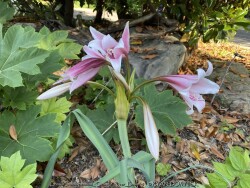

Crinums are tough, long-lived perennial bulbs with strappy leaves and fragrant, funnel-shaped flowers. In areas where the bulbs are hardy, (zones 5/6-10) these plants can reach as much as 4 feet across and bloom all summer. Crinums can live for 200-300 years in the South often found growing in cemeteries and abandoned home sites with little or no attention. The plants are native to southeast Asia often in areas with a summer monsoon and dry winter. They can also be grown as flowering summer patio plants. If growing as a potted plant and trying to overwinter, allowing the foliage to frost is ok, it will not kill the root system. However, do not allow the pot with rootball to freeze solid or go below 20 degrees for more than a few hours; move into a cold garage or basement over the winter with no watering. Cut back and allow to go dormant and place entire pot back out in April or May with a time-release fertilizer. During the growing season, fertilize, water regularly, and place in full sun. You may also plant these in the ground for an enormous tropical effect! It is easy to overwinter these in the ground in Kansas with mulch or no mulch! The trick is to plant them deep: an extra 4-6" deeper than grade or with neck of bulb completely buried. Crinums are extremely adaptable thriving in either in dry or in boggy soils. Crinums are tough, low maintenance bulbs which make them perfect for rain gardens, and although drought-tolerant, crinums bloom more if well-watered. Unlike southern climates, crinums in Kansas need full sun to grow and flower in our shorter growing season. Crinum are more cold hardy than most authorities publish; easily pushing into zone 5 for some varieties. In our trial gardens in Lawrence, KS (zone 6a), the following varieties survived after being mulched 6-12" with leaf mulch to -17 degrees F. (Crinum 'Infusion', Crinum tweedianum, Crinum 'Super Ellen', Crinum x powellii, Crinum 'White Prince') During the arctic blast of February, 2021, lows down to -17 degrees F on Feb 16th, 2021 were recorded. The longevity of this cold blast was also impressive: 10 days on a row with highs of 10-15 degrees F or lower, 8 nights of lows in the single digits and negatives, and 36 straight hours of 0 degrees F and mostly lower. No crinums were lost or harmed during this event! Crinum bulbispermum 'Orange River Basin' is a form of the extremely winter hardy (zone 5) Crinum bulbispermum from South Africa's Orange River area at around 9,000' elevation 'Orange River Basin' forms a lovely non-offsetting clump of glaucous blue foliage and white flowers with pink and magenta throat.
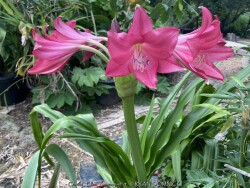

Crinums are tough, long-lived perennial bulbs with strappy leaves and fragrant, funnel-shaped flowers. In areas where the bulbs are hardy, (zones 5/6-10) these plants can reach as much as 4 feet across and bloom all summer. Crinums can live for 200-300 years in the South often found growing in cemeteries and abandoned home sites with little or no attention. The plants are native to southeast Asia often in areas with a summer monsoon and dry winter. They can also be grown as flowering summer patio plants. If growing as a potted plant and trying to overwinter, allowing the foliage to frost is ok, it will not kill the root system. However, do not allow the pot with rootball to freeze solid or go below 20 degrees for more than a few hours; move into a cold garage or basement over the winter with no watering. Cut back and allow to go dormant and place entire pot back out in April or May with a time-release fertilizer. During the growing season, fertilize, water regularly, and place in full sun. You may also plant these in the ground for an enormous tropical effect! It is easy to overwinter these in the ground in Kansas with mulch or no mulch! The trick is to plant them deep: an extra 4-6" deeper than grade or with neck of bulb completely buried. Crinums are extremely adaptable thriving in either in dry or in boggy soils. Crinums are tough, low maintenance bulbs which make them perfect for rain gardens, and although drought-tolerant, crinums bloom more if well-watered. This plant can also grow in standing water or as a potted plant in water gardens. Unlike southern climates, crinums in Kansas need full sun to grow and flower in our shorter growing season. Crinum are more cold hardy than most authorities publish; easily pushing into zone 5 for some varieties. In our trial gardens in Lawrence, KS (zone 6a), the following varieties survived after being mulched 6-12" with leaf mulch to -17 degrees F. (Crinum 'Infusion', Crinum tweedianum, Crinum 'Super Ellen', Crinum x powellii, Crinum 'White Prince') During the arctic blast of February, 2021, lows down to -17 degrees F on Feb 16th, 2021 were recorded. The longevity of this cold blast was also impressive: 10 days on a row with highs of 10-15 degrees F or lower, 8 nights of lows in the single digits and negatives, and 36 straight hours of 0 degrees F and mostly lower. No crinums were lost or harmed during this event!
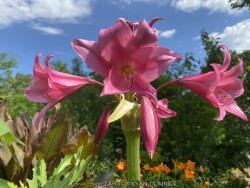

Crinums are tough, long-lived perennial bulbs with strappy leaves and fragrant, funnel-shaped flowers. In areas where the bulbs are hardy, (zones 5/6-10) these plants can reach as much as 4 feet across and bloom all summer. Crinums can live for 200-300 years in the South often found growing in cemeteries and abandoned home sites with little or no attention. The plants are native to southeast Asia often in areas with a summer monsoon and dry winter. They can also be grown as flowering summer patio plants. If growing as a potted plant and trying to overwinter, allowing the foliage to frost is ok, it will not kill the root system. However, do not allow the pot with rootball to freeze solid or go below 20 degrees for more than a few hours; move into a cold garage or basement over the winter with no watering. Cut back and allow to go dormant and place entire pot back out in April or May with a time-release fertilizer. During the growing season, fertilize, water regularly, and place in full sun. You may also plant these in the ground for an enormous tropical effect! It is easy to overwinter these in the ground in Kansas with mulch or no mulch! The trick is to plant them deep: an extra 4-6" deeper than grade or with neck of bulb completely buried. Crinums are extremely adaptable thriving in either in dry or in boggy soils. Crinums are tough, low maintenance bulbs which make them perfect for rain gardens, and although drought-tolerant, crinums bloom more if well-watered. This plant can also grow in standing water or as a potted plant in water gardens. Unlike southern climates, crinums in Kansas need full sun to grow and flower in our shorter growing season. Crinum are more cold hardy than most authorities publish; easily pushing into zone 5 for some varieties. In our trial gardens in Lawrence, KS (zone 6a), the following varieties survived after being mulched 6-12" with leaf mulch to -17 degrees F. (Crinum 'Infusion', Crinum tweedianum, Crinum 'Super Ellen', Crinum x powellii, Crinum 'White Prince') During the arctic blast of February, 2021, lows down to -17 degrees F on Feb 16th, 2021 were recorded. The longevity of this cold blast was also impressive: 10 days on a row with highs of 10-15 degrees F or lower, 8 nights of lows in the single digits and negatives, and 36 straight hours of 0 degrees F and mostly lower. No crinums were lost or harmed during this event!
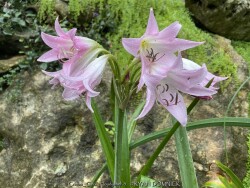

Crinums are tough, long-lived perennial bulbs with strappy leaves and fragrant, funnel-shaped flowers. In areas where the bulbs are hardy, (zones 5/6-10) these plants can reach as much as 4 feet across and bloom all summer. Crinums can live for 200-300 years in the South often found growing in cemeteries and abandoned home sites with little or no attention. The plants are native to southeast Asia often in areas with a summer monsoon and dry winter. They can also be grown as flowering summer patio plants. If growing as a potted plant and trying to overwinter, allowing the foliage to frost is ok, it will not kill the root system. However, do not allow the pot with rootball to freeze solid or go below 20 degrees for more than a few hours; move into a cold garage or basement over the winter with no watering. Cut back and allow to go dormant and place entire pot back out in April or May with a time-release fertilizer. During the growing season, fertilize, water regularly, and place in full sun. You may also plant these in the ground for an enormous tropical effect! It is easy to overwinter these in the ground in Kansas with mulch or no mulch! The trick is to plant them deep: an extra 4-6" deeper than grade or with neck of bulb completely buried. Crinums are extremely adaptable thriving in either in dry or in boggy soils. Crinums are tough, low maintenance bulbs which make them perfect for rain gardens, and although drought-tolerant, crinums bloom more if well-watered. This plant can also grow in standing water or as a potted plant in water gardens. Unlike southern climates, crinums in Kansas need full sun to grow and flower in our shorter growing season. Crinum are more cold hardy than most authorities publish; easily pushing into zone 5 for some varieties. In our trial gardens in Lawrence, KS (zone 6a), the following varieties survived after being mulched 6-12" with leaf mulch to -17 degrees F. (Crinum 'Infusion', Crinum tweedianum, Crinum 'Super Ellen', Crinum x powellii, Crinum 'White Prince') During the arctic blast of February, 2021, lows down to -17 degrees F on Feb 16th, 2021 were recorded. The longevity of this cold blast was also impressive: 10 days on a row with highs of 10-15 degrees F or lower, 8 nights of lows in the single digits and negatives, and 36 straight hours of 0 degrees F and mostly lower. No crinums were lost or harmed during this event! Crinum x powellii produces pink flowers. 48" tall